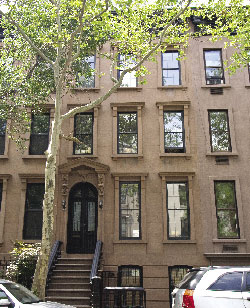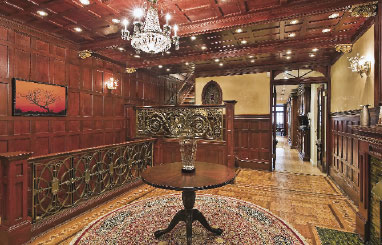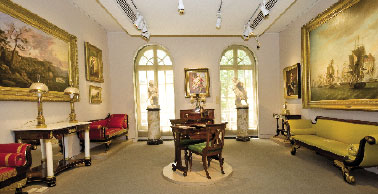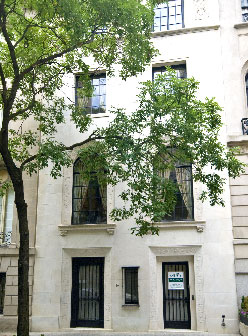
156 West 88th Street
On the gutted second floor of 34 East 68th Street, residential real estate broker George van der Ploeg is giving a mini-lecture on 19th-century architecture.
A rectangular staircase pillar isn’t original to the 1879 brownstone, says van der Ploeg, who is marketing the $11.975 million listing with fellow Prudential Douglas Elliman broker Nancy Aryeh. (To read the sidebar on Manhattan buyers’ preference for historic townhouses over newly built houses, click here)
However, another round post a few feet away, topped with an elaborate handrail, “is original, and would have been mahogany, though it’s covered with about 10 layers of paint,” he says.
The two posts look nearly identical to the untrained eye, but they are “just not the same period,” says van der Ploeg, a longtime townhouse broker who loves browsing the Met’s French Rococo and Neoclassical collections in his free time.
Townhouse specialists like van der Ploeg are a vanishing breed.
When he sold his first Manhattan house in 1990, townhouse sales were still an often-overlooked backwater of the real estate market, and the primary requirement for selling them was a willingness to master reams of esoteric data about zoning and FAR. For years, a tight-knit group of brokers who specialized in townhouses had the field largely to themselves.
But after two decades of dwindling crime and soaring real estate prices, the insular world of townhouse brokers is under siege.

436 East 87th Street
A report released last month by appraisal firm Miller Samuel pegged the median sales price of a Manhattan townhouse at $3.85 million, up an eye-popping 114.5 percent from $1.8 million in 2001. These high prices have lured the city’s apartment brokers, who now consider townhouse sales a crucial part of their business. A well-known handful of brokers — like Jed Garfield, Wolf Jakubowski and Paula Del Nunzio — have long dominated the townhouse sector, but they now face increasing competition for listings from powerhouse brokers straddling both the apartment and townhouse worlds. At the same time, it’s unlikely that a new generation of specialists will take their place, since it’s harder than ever for newbie brokers to gain townhouse expertise.
Today, it’s “much more competitive,” said Garfield, head of the townhouse brokerage Leslie J. Garfield & Co., founded by his father in 1972. “We used to sort of have the market to ourselves, and now everybody does it. I mean, everybody.”
The cerebral set
In surveying the divisions within residential real estate, it’s helpful to borrow from the classic 1980s movie “The Breakfast Club.” The jock played by Emilio Estevez embodies the stereotypical, aggressive broker in the fast-paced world of new condos; popular, wealthy Molly Ringwald represents socially connected co-op brokers; and until recently, the more cerebral Anthony Michael Hall would approximate the townhouse specialist — operating in an often separate world of facts and figures.
“I like research, I like studying things,” said van der Ploeg, recalling how he transitioned away from condos and co-ops to townhouses in 1990.

313 West 71st Street
Tim Desmond, a Stribling senior vice president who is currently listing an Anglo-Italianate townhouse at 47 West 9th Street for $28.5 million, has focused on single- and multifamily homes in Manhattan since 1983. “Back then, there was a real division between townhouse brokers and apartment brokers,” he said. “A lot of apartment brokers were scared of houses, and just wanted to stay away from them, because they didn’t know a lot about them.”
The niche is complex: Many New York townhouses are landmarked, requiring extensive knowledge about zoning, taxes and air rights.
“The kind of information that you need to have is just different,” said van der Ploeg, who sold his first townhouse to Talking Heads frontman David Byrne, and has since done some $300 million in townhouse sales. “In the most expensive co-op buildings, you need to know who’s on the board, who’s in the building. When you sell townhouses, none of that matters.”
Until recently, there was little incentive for brokers to master these complex transactions.
In the late 1800s and early 1900s, wealthy New Yorkers lived in single-family houses made of brownstone, limestone or brick, according to Brown Harris Stevens’ Jakubowski, who has sold more than $1 billion worth of townhouses since 1979. But during the Great Depression and the waves of suburban migration following World War II, many of these once-opulent mansions were abandoned and converted into multifamily rentals or single-room occupancy buildings, also known as SROs. The Upper East Side remained a home base for the rich, but areas like Greenwich Village and the Upper West Side became “very tough,” Jakubowski recalled.
In the 1960s and ’70s on the West Side, “you could buy any house on a park block for $30,000,” he said. It wasn’t until the 1980s that the area “became a viable market where people would actually pay real money for a house.”

Not surprisingly, “there weren’t that many house brokers back then,” Desmond recalled. Those who did sell houses tended to specialize, especially since multifamily rental buildings served as tax shelters until the mid-1980s. That meant they were routinely bought and sold with rent-stabilized tenants in place, a complicating element that deterred many brokers.
“A lot of co-op brokers were uncomfortable selling multi-unit houses,” Desmond said, adding: “It was a lot easier to sell an apartment.”
Fending off competition
All of that shifted as property values began to rise. Changes to tax laws in the 1980s created an incentive for townhouse owners to remove tenants and create single-family homes for the rich. Meanwhile, the real estate industry was undergoing a seismic shift, as a wave of conversions transformed rentals into for-sale properties, luring a wave of new brokers into real estate.
“You have to remember that the brokerage business as it is today is really only about 30 or 35 years old,” said veteran Corcoran broker Deanna Kory, who started in real estate in 1985. At the time, she recalled, it felt like “everybody who was coming into the business was a brand-new broker.”
Even then, it wasn’t easy to break into the townhouse field, said Kory, who now sells between two and four townhouses a year, in addition to having a busy apartment business.
“I was fortunate enough to get a townhouse here, a townhouse there, and then I built on that,” Kory said. Even so, she recalls that when she first had townhouse listings, “people would always say, ‘She doesn’t know what she’s doing.'”
That’s likely because the field was dominated by people like Jakubowski, who estimated that he’s sold only about three apartments since entering the business in 1979; the rest have been houses.

21 East 70th Street
Garfield learned the business at the knee of his legendary father. “I’ve been showing houses with Leslie since I was a little boy,” the younger Garfield recalled.
Longtime townhouse broker Dexter Guerrieri, who founded the West Side townhouse brokerage Vandenberg Inc. in 1989, said he had “an old-fashioned apprentice relationship” with Austin Haldenstein, founder of Austin Haldenstein Real Estate, the “go-to company for townhouse sales” on the West Side in the ’60s, ’70s and ’80s.
But as prices have risen, more and more brokers have been tempted to try out townhouse sales.
“Now the pricing is way up there,” Jakubowski said. “The volume is such that you can make a very handsome living selling houses.”
As a result, the once distinct line between townhouse and apartment brokers has become increasingly blurred, especially as websites like StreetEasy and PropertyShark make once obscure townhouse information more widely available.
Superbrokers like Dolly Lenz, Carrie Chiang and Serena Boardman have added houses to their array of multimillion-dollar listings. The reverse is also beginning to occur: Brown Harris Stevens’ Del Nunzio, a top townhouse broker, also sells co-ops and condos in addition to her glittering roster of townhouse listings. Right now, for example, she’s listing a triplex penthouse at 552 LaGuardia Place for $8.75 million and a $6.9 million co-op at the Osborne on 57th Street, in addition to listings like a $35 million townhouse at 170 East 80th Street.
“Once you get into the Carries and Dollys and Paulas, they cover all the bases of the high end,” Guerrieri said.
The increasing interest of superbrokers in townhouses has “cut into our business,” Garfield said.
With so many competing brokers out there, buyers these days have “no loyalty,” Garfield said. “It definitely forced us to work a lot more on getting exclusive agency work [rather] than doing buy-side transactions,” he said. That means, for example, spending more time making phone calls to owners soliciting listings.
Preferring known quantities
Despite the growing competition, a handful of brokers still do the majority of townhouse deals.
“If you look at it year in, year out, year after year, you will probably see the same names making the largest deals,” Garfield said. “Certainly, when an owner is interviewing brokers, I regularly run into the same people.”
When it comes to townhouses, which tend to be much pricier than other types of listings, established brokers have a considerable advantage over newcomers to the field.
“If you don’t have a track record, it’s going to be hard to get hired,” van der Ploeg said. “If your friend has just gotten into the real estate business and wants to show you apartments, you don’t have much to lose. But if your friend wants the exclusive on your townhouse, the stakes are higher.”
For example, Seagram heir Edgar Bronfman Jr. is allowing his daughter Vanessa, a newly minted agent at Key Ventures, to help market his $27.25 million townhouse on 69th Street — but only alongside Chiang and Del Nunzio as the listing agents.
Plus, established brokers prefer to deal with each other than to take a chance on someone who might jeopardize a pricey, complex deal. That makes it hard for new brokers to get the experience they need to become exclusive townhouse specialists.

20 East 64th Street
In this economic climate in particular, with fewer townhouse sales, clients are more likely to choose experienced brokers than inexperienced ones. According to Miller Samuel, there were 197 Manhattan townhouse sales in 2010, down from the annual average of 246 over the past decade.
During the boom, “you didn’t have to hire somebody with a lot of experience because the market was so crazy,” van der Ploeg said. “Now, buyers are much more disciplined. The quality and experience level of brokers means a lot more.”
Even among brokers who work together frequently, relations can be tense.
Garfield freely admitted that he doesn’t get along with Del Nunzio, calling her “deceptive” and adding that he feels she fails to give other brokers credit for deals. For example, he said, Del Nunzio glosses over his role in representing buyer Tamir Sapir in 2006, in the purchase of the Duke Semans Mansion at 1009 Fifth Avenue for $40 million. The listing brokers were Del Nunzio and Shirley Mueller from Brown Harris Stevens, and Sharon Baum from the Corcoran Group.
“If you believe Paula’s press, you would think she’s the one who [originally] sold 1009 Fifth Avenue,” he said. “I sold it to Sapir four years ago — he was my customer.”
Del Nunzio declined to comment on the matter.
Tensions also sometimes flare between townhouse specialists and brokers who have less experience with houses.
“There are new people coming in and they’re representing themselves as being knowledgeable, and they’re oftentimes not,” Jakubowski said. With these newer brokers, “I have to double-check what I’m being told, whereas if I get it from a more established broker, I just know I can trust that if they’re telling me it’s got a [certain] FAR that’s buildable, I can pretty well rely upon it.”
For her part, Kory said clients may not always be best served by brokers who specialize only in townhouses, whom she feels are “missing a little bit of the breadth of the market” since there is some crossover between apartment and townhouse buyers.
“The townhouse group, in my opinion, is a little bit staid,” she said. “That’s why I think somebody who is more understanding of what goes on [in the market] may be better.”
It’s not impossible for a new broker to develop an expertise in townhouses. One way is to work with a more experienced broker, said Jakubowski. He has trained a number of assistants (though he noted that most these days go on to sell both townhouses and apartments). Apartment brokers also sometimes partner with townhouse brokers at their firms.
Still, it’s not easy. “You’ve got to pay your dues and hang in there,” Guerrieri said.
